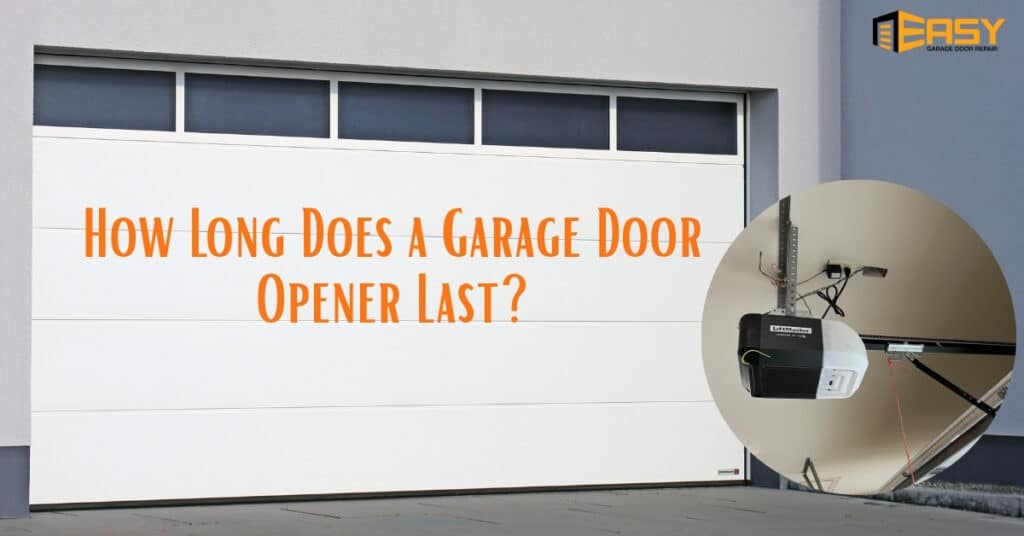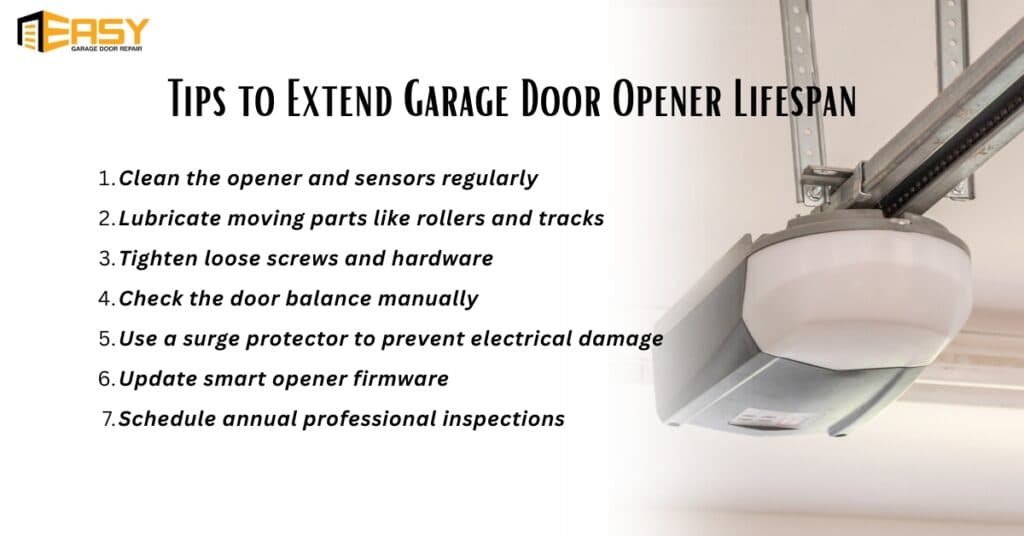
A garage door opener allows for automatic door opening and closing to add convenience and safety. The main function of the opener is to raise and lower the garage door using a motor-driven mechanism. But how long does a garage door opener last before needing a replacement? The average lifespan of an opener depends on the opener type and daily usage.
On average, a garage door opener in a residential home lasts around 10 to 15 years. Even if the door opener still works, that doesn’t mean it’s safe or worth keeping. If your opener lacks safety features or has trouble opening and closing the door, it’s a sign you need to replace it.
How Long Do Garage Door Opener Components Last?
Many openers run for more than 15 years when given regular maintenance. Others give up early because of poor installation or lack of upkeep. A 15-year-old opener might still open your door, but it may lack modern features. So, lifespan isn’t just about time but about performance and convenience.
LiftMaster and Chamberlain garage door openers can work reliably for 15 to 20 years if they’re well maintained.
As for the battery inside the opener, it typically needs replacing every 1 to 2 years with regular use.
When it comes to garage door remotes, the lifespan varies. A well-built, properly cared-for remote used a few times a day can last over five years. On the other hand, cheaper remotes or ones exposed to extreme temperatures may stop working after just a year or two.
When to Replace Your Garage Door Opener?
Knowing when it’s time to replace your garage door opener is as important as understanding how long it lasts. These are the most common and overlooked signs that it’s time for a garage door service or full replacement.
1. You Notice Frequent Repairs
If you’re constantly fixing the motor, chain, or circuit board, it’s more cost-effective to replace the entire unit. Multiple repairs can cost more than a new opener. If you find yourself calling a technician more than once a year, that’s your opener telling you it’s nearing the end of its life. Sensors, gears, logic boards, or remote replacements repeatedly add up in money and frustration.
2. It’s Making Strange Noises
All openers make some noise, but if you hear:
Grinding → Worn-out gears
Squeaking → Lack of lubrication or motor strain
Loud rattling → Loose components
These sounds point to faulty internal parts. If you can hear your opener from inside the house, it’s likely time to upgrade to a quieter system.
3. Outdated Safety Features
If your opener was made before 1993, it may not comply with current federal safety standards. These older garage door openers lack photo-eye sensors, auto-reverse systems, and rolling code technology. A failing sensor could allow the door to close on a person, pet, or vehicle. Replacement is non-negotiable if safety is compromised.

4. Inconsistent Remote or Wall Button Response
If you notice delays, missed signals, or the door only responding after multiple attempts, the opener’s logic board or signal receiver may be failing.
This could be caused by:
- Worn-out circuitry
- Interference from other wireless devices
- Battery drain due to outdated tech
Smart openers today come with encrypted wireless signals, mobile app control, and even Wi-Fi troubleshooting. If your opener is struggling to connect, it’s already behind the times.
5. No Backup Power for Outages
If your opener stops working during a power outage, it’s a serious problem, especially if you use it daily. New openers come with battery backups that allow operation for up to 24 hours during a blackout. They’re lifesavers during storms, rolling outages, or emergencies. If your current model leaves you stranded during outages, it’s time to replace it.
How to Extend Your Garage Door Opener’s Lifespan?
A garage door opener lifts hundreds of pounds multiple times a day. Even though most openers last 10 to 15 years, good maintenance can stretch that lifespan. Here’s how to keep it working like new.
1. Keep the System Clean and Dust-Free
Dust builds up fast in garages. It clogs sensors, chokes the motor housing, and coats the circuit board over time. This causes overheating and electrical issues.
- Wipe down the motor housing and tracks every few months.
- Gently clean around the photo-eye sensors with a soft cloth.
- Use a dry brush to dust around vents and moving parts.
- Never spray water or cleaning products directly onto the opener. Always apply cleaner to the cloth first.
2. Lubricate, Tighten, and Inspect Moving Parts
The motor works harder when metal parts grind against each other. Lubricate the trolley rail, chain or screw drive, hinges, rollers, and springs. All that vibration gradually loose bolts and screws. It puts strain on your opener. Every 4–6 months:
- Check and tighten mounting brackets
- Inspect chain tension (for chain-drive openers)
- Examine rail alignment and support arms

3. Balance and Maintain the Garage Door
Opener doesn’t lift the door alone. The springs and tracks are mainly involved in the door movement. The opener gets overloaded because of an unbalanced door. Check the door balance by disconnecting the opener using the manual release.
Lift the door halfway by hand. If it stays in place, it’s balanced. If it falls or shoots up, it’s not. Avoid DIY attempts and have a professional for balance adjustments if needed.
4. Use a Surge Protector
Power surges can damage the opener’s logic board in seconds. This risk grows in areas with frequent lightning or unstable grids. Plug the opener into a high-quality surge protector. It costs less than a repair and can save your system from permanent damage.
Most homeowners may require frequent opener replacements because of nearby lightning strikes until a technician installs a surge protector.
5. Update Firmware and Monitor Smart Features
Check for firmware updates if you use a smart opener. Brands like LiftMaster and Chamberlain release software patches to fix bugs and improve Wi-Fi performance. Keep your app connected, monitor usage logs, and set up push notifications to catch unusual behavior early.
6. Schedule Annual Professional Inspections
Some issues aren’t visible, like failing motor capacitors or micro-cracks in the rail. A garage door professional can spot these before they cause breakdowns. They check opener motor health, sensor alignment, and overall garage door condition. This is especially helpful if your opener is 7+ years old or you notice performance changes.
Final Words
Well-functioning opener means a well-functioning garage door. You can protect the opener by understanding how long a garage door opener lasts and the time for an upgrade. Taking these simple maintenance steps protects the opener and ultimately your peace of mind.
The door reverses or doesn’t close because of a failing opener. Rather than just waiting for an emergency, it’s better to call experts for smart opener upgradation. When you want expert help or advice on choosing the right opener, get in touch with our team serving all across Houston.
Easy Garage Door Repair offers free consultation and professional opener installation services. Reach out to our team today.








